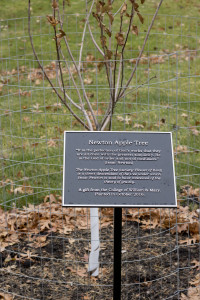Cuttings from Isaac Newton’s Tree Planted in Houghton
For centuries, elementary school teachers have told their students the story of the apple that fell from a tree onto Sir Isaac Newton’s head, sparking an idea about a new theory of universal gravitation. Now visitors to Houghton College can find two young saplings, descendants of those famous apple trees, growing beside the Paine Science Center.

The trees were a gift to Houghton from president Taylor Reveley of the College of William & Mary in Williamsburg. The Virginia college received their trees from the Massachusetts Institute of Technology, which in turn obtained cuttings of Newton’s original trees from the Royal Botanical Gardens in London. William & Mary’s Assistant to the Provost, Houghton alumnus Jeremy Martin, helped to facilitate the trees’ journey to Houghton.
While the truth of the apple tree anecdote has never been confirmed, Newton’s reputation as one of the most brilliant and wide-ranging scientific minds of all time has been assured since the publication of his three-part Principia, a seminal point in the development of physics. Over the years, the story of the Newton Tree has endured as a powerful emblem of scientific curiosity. A small cutting of the tree even made it as far as the International Space Station, when The National Aeronautics and Space Administration (NASA) astronaut, Piers Sellers, carried it on board the shuttle Atlantis in 2010.
Thus the arrival of the trees is perfectly timed, as this year’s freshman physics class was the largest in several years and the department is poised to soon introduce an engineering degree. “It’s kind of an exciting time for physics,” said Mark Yuly, professor of physics and chair of the mathematics and natural science department. He continued, “And I think the tree is something that represents the past and represents the future.”
According to the Houghton website, the trees were dedicated over Homecoming weekend, with speeches from college president, Shirley Mullen; professor of biology,James Wolfe; and assistant professor of physics, Kurt Aikens commemorating the occasion before an audience of alumni. A plaque beside the trees bears a quote from Newton himself and states, “It is the perfection of God’s works that they are all done with the greatest simplicity. He is the God of order and not confusion.”
Throughout his life, Newton wrote extensively on, not only science, but also theology and Biblical interpretation. For this very reason, Mullen believes the tree’s significance extends far beyond its worldly fame, symbolizing the fundamental and forgotten unity between science and faith. “One of the great tragedies of the modern period is how in our culture science and faith have become separated,” she said. “In many people’s minds, they’re actually viewed as antagonistic. That is so historically wrong, and so counter to what the actual history of faith and science has been. In a sense, this is a way of inspiring the retelling of a larger vision of faith and science.”
